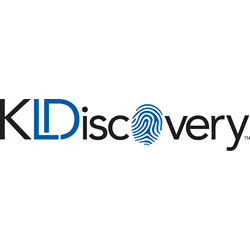HSR Filings Just Got More Complex—Here’s How Legal Teams Are Adapting
By Nyah King and Jordan Chelovich | Presented by KLDiscovery
May 13, 2025

Nyah King is KLDiscovery’s Global Director of Project Management, Legal Technologies. She leads KLD’s Regulatory & Investigation Services team responsible for consulting clients through the EDRM lifecycle.
Jordan Chelovich is KLDiscovery’s Director, Global Managed Review Services. Chelovich spearheads the Regulatory Compliance team, providing strategic counsel to clients on best practices and cutting-edge technologies for optimal efficiencies on regulatory matters.
Published in Today’s General Counsel, June 2025

Sponsored Content
Presented by KLDiscovery
Regulatory pressure rarely announces itself politely. It builds quietly through vague agency guidance, evolving expectations, and deadlines that do not care how resourced your team is. The new Hart-Scott-Rodino (HSR) rules have added complexity for corporate legal departments and shifted the entire risk calculus for merger and acquisition deals. And while the rules changed, the expectations did not. Faster turnaround, airtight accuracy, and nothing left behind. In this climate, even top firms are reconsidering what they should handle internally and what is smarter to outsource.
Expanded HSR Requirements: What’s Changed
The revised HSR rules have fundamentally reshaped compliance. What was once a short-term procedural step now demands deeper documentation, broader custodian inclusion, and far more sophisticated review workflows.
Under the new rules, parties must submit narrative descriptions of business operations and produce significantly more documents related to investment interests and competitive overlaps. Custodian lists are longer, data volumes are higher, and regulators are asking more questions earlier in the process.
According to KLDiscovery’s internal metrics, the average size of HSR productions increased by nearly 40 percent in the first 90 days after the new rules took effect. Requests that once involved 8 to 10 custodians now routinely extend to 25 or more. Review timelines haven’t shifted, but the demands have.
For in-house teams and outside counsel, the challenge is not just about compliance. It’s about bandwidth. Teams that once handled filings in-house are now stretched thin, reassigning high-value talent to triage documentation and review. This misalignment drains internal resources and creates risk, especially as regulators continue to evolve their expectations without much warning.
What Legal Teams Are Craving: Real-Time Frontline Insight
The legal departments feeling the most pressure right now are not necessarily short on knowledge. What they lack is visibility into how others are responding. In an environment where regulators are moving faster, and filings are under greater scrutiny, knowing what’s ‘market standard’ has never been more valuable.
That is why some of the largest U.S. law firms have shifted how they engage with KLDiscovery. They are no longer asking who we are or what we do. Instead, they want to know what we see across industries and regulators. What workflows are getting traction with the Department of Justice (DOJ)? How are other clients handling multilingual reviews or nonstandard formats? What are the early signs of regulator pushback?
It is not uncommon for even sophisticated practices to handle just a few Second Requests or HSR filings each year. In contrast, KLDiscovery supports dozens annually, often in simultaneous jurisdictions and under compressed timelines. That volume gives us a unique vantage point—one that clients are actively seeking out.
One theme has emerged across client conversations this year: legal teams are looking for partners who can shorten the learning curve. They want answers grounded in experience, not theory. And they want solutions that scale without adding more to their plate.
KLDiscovery’s Answer: Introducing HSR Navigator
As legal teams face increased regulatory complexity with fewer internal resources, KLDiscovery has developed a purpose-built solution: HSR Navigator.
Unlike general eDiscovery platforms that are retrofitted for compliance tasks, HSR Navigator was designed from the ground up to align with the expanded demands of Hart-Scott-Rodino filings. It combines legal expertise, technical precision, and scalable infrastructure in a single offering so legal teams can respond confidently, even under pressure.
At the core of HSR Navigator is a team of specialists focused solely on regulatory and antitrust matters. These project managers, analysts, and attorneys manage the entire eDiscovery lifecycle, from custodian identification and document collection to multilingual review and regulator-ready production.
Integrated Nebula Analytics brings advanced capabilities like AI-powered clustering, keyword prioritization, and translation support. These tools are not just powerful; they are calibrated specifically for HSR workflows.
Pricing is transparent and predictable. Clients are billed per custodian or document volume, with no hidden costs and hosting included for up to three months. Whether the matter involves ten custodians or a hundred, HSR Navigator scales accordingly.
Infrastructure and personnel adjust to meet demand without forcing clients to invest in additional internal systems or headcount. This is not just an outsourced process. It is a streamlined extension of your legal team.
Why Legal Teams Are Turning to Outside Help
The expanded HSR requirements have pushed many legal departments to a tipping point. What used to be a focused procedural step now requires broader document collections, more custodians, and tighter deadlines. For teams already balancing internal investigations, regulatory response, and day-to-day legal work, it’s a lot to absorb.
Rather than stretch limited resources even thinner, some teams are shifting their approach. They are carving off the most time-consuming parts of the process—custodian interviews, document translation, exception tracking—and working with outside support that can step in quickly and handle the volume.
This isn’t about outsourcing for the sake of efficiency. It’s about protecting internal capacity for the work that truly requires institutional knowledge or legal judgment. The rest, especially the operational execution, can often be done faster and more effectively by teams who handle this type of work every day.
The goal for legal departments under pressure is not to do more with less. It’s to stay focused on the right things while still meeting increasingly complex demands.
Industries in the Crosshairs: What to Watch
While the new HSR rules apply across the board, certain sectors are feeling the impact more acutely. Life sciences and healthcare remain a central focus for regulators, especially in the wake of consolidation trends and prior enforcement actions. Technology and energy are also drawing increased scrutiny as regulators look more closely at data use, competitive positioning, and vertical integration.
Private equity and venture capital continue to appear in conversations, though opinions differ on whether these will remain enforcement priorities. Some expect the current administration to return focus to traditional antitrust theories. Others believe investment structures and roll-up strategies will still attract regulatory interest under expanded disclosure requirements.
Regardless of sector, one trend is clear. The complexity of HSR filings is rising, and legal teams across industries are adjusting their approach. Many are moving from reactive workflows to proactive strategies, building capacity, exploring technology partnerships, and looking to streamline wherever possible.
KLDiscovery’s HSR Navigator is already supporting clients across these high-scrutiny industries, helping them reduce internal strain, increase filing precision, and prepare for regulator review before the clock starts ticking.
The New Stakes of HSR Compliance
Hart-Scott-Rodino compliance has always been a high-visibility aspect of regulatory readiness, but recent changes have significantly increased the complexity and operational demands. What was once a tightly scoped process now requires broader coordination, faster execution, and deeper resources to get right.
Legal departments that treat HSR filings as a strategic risk are better equipped to manage rising complexity. That means investing in the right partners, aligning workflows with regulator expectations, and shifting from reactive to proactive readiness.
KLDiscovery’s HSR Navigator was built for this exact moment. It offers legal teams a purpose-built way to navigate expanding regulatory requirements without overwhelming their people, systems, or timelines. Compliance becomes faster, smoother, and fully defensible with the right infrastructure, expertise, and tools.
The filings are getting harder. The expectations are rising. The teams that adapt first will set the standard.
Must read intelligence for general counsel
Subscribe to the Daily Updates newsletter to be at the forefront of best practices and the latest legal news.
Daily Updates
Sign up for our free daily newsletter for the latest news and business legal developments.




